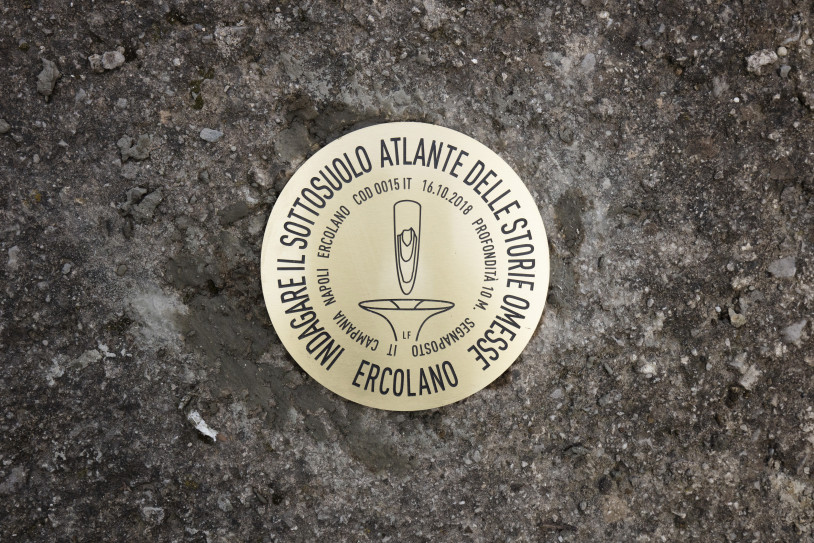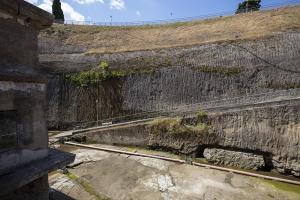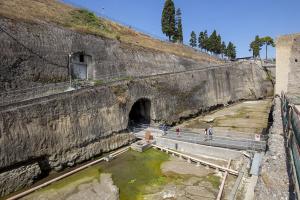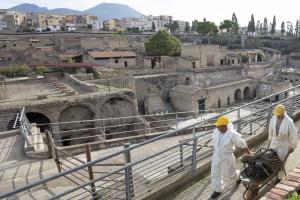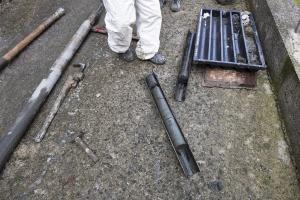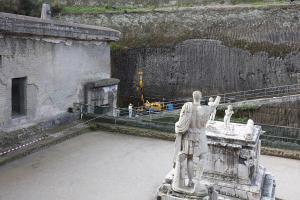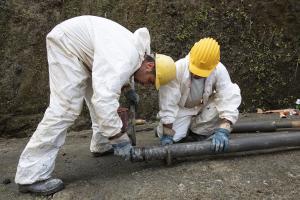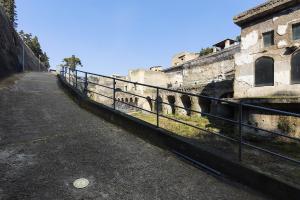
When the waters at the base of the Suburban Baths were drained, a skeleton came to light. It was 1980 and that skeleton was just the first of many human remains to be found, turning on its head the comforting idea that almost all the people of Herculaneum had survived the eruption of Vesuvius in 79 AD. The beach and the arches that held up the terrace of the baths and of the sacred area, which were used for maintaining and sheltering boats, turned out to be a cemetery of skeletons: over 250 were found along less than a hundred metres of seashore. The original conformation of the site was obliterated by the thick blanket of pyroclastic material, which pushed the coastline some hundreds of metres further out. In a desperate attempt to save themselves, the inhabitants of Herculaneum packed into the arcades that gave onto the sea, and it was here that the greatest number of victims were found. The contraction of the limbs shows that the bodies were subjected to high temperatures, and their open mouths that they were gasping for breath, with their windpipes blocked. Unlike the victims in Pompeii, who were buried by layers of ash that then hardened, the dozens of metres of ash that covered those trying to flee Herculaneum remained moist, gradually enveloping the bodies as the soft tissues decomposed, preserving the bones. Considering that the Romans used to cremate their dead, these skeletons are an exceptional discovery for biological anthropology, offering a virtual census of the population at the time.
On 3 August 1982, during excavation of the ancient marina, a charred wooden boat, placed upside down, was unearthed a few metres from the Suburban Baths. Near the keel was the skeleton of a man, probably a soldier, aged 37 and about 1.8 metres tall, wearing a belt from which hung a dagger and a gladius. A bag with twelve silver and two gold coins was found nearby. He had lost a number of teeth, probably in a fight – maybe the one in which he had been struck by a pointed weapon that had cut into his left femur. The regular development of his bones showed that his nutrition had been good and the head of his femur appeared worn down, as found in people who spend a long time riding. The carpentry tools found next to the skeleton – a bag containing a hammer and two chisels for wood – probably show how, in peacetime, the soldiers were used for construction work. He had probably just got off the boat, possibly a lifeboat, in a bid to rescue the many Herculaneans who had raced down to the beach. Here we see not just the lifestyle and customs of the time, but also the final hours of Herculaneum, with the feverish stampede of a panic-stricken population.

Founded during the Samnite period, Herculaneum was one of the circum-Vesuvian cities buried by the great eruption of Vesuvius in AD 79. This was the area hit by its most violent and sudden phenomena (pyroclastic flows mostly at high temperatures) and where it left its thickest deposits (up to 25 m).
The 0015 core sampling site is in the archaeological area of the Herculaneum excavations, on the ramp that goes down to the pumping plant and to the coastal tuff platform on which the ancient beach had formed. Straight cuts and grooves on this platform have been identified as traces of ancient quarrying activities for the extraction of blocks of tuff used for building the city. Where it has been uncovered by archaeological excavations, the tuffaceous platform, which was once out of the water, is now about 6.5 m below sea level due to the subsidence of the ground caused by volcanic-tectonic phenomena. A pumping system removes the groundwater, which would otherwise fill the area.
The sand deposited on the quarry site dates from two different periods of marine transgression, the first dating from the early first century AD, and the second from the final part of the city’s last decade, before the fatal eruption in AD 79.
The ramp on which the core sampling site is located cuts through the deposits of the AD 79 eruption, which are exposed and clearly visible along the entire front of the excavation. The core sampling site is in the lower part of the ramp and thus goes only through the lower portion of the sequence, at -2.65 m below the paving of the ramp.
Beneath the eruptive layer there is a thin layer, of 5 cm, with a concentration of carbonised organic substances, including minute fragments of wood and plants (US3) burnt by the eruptive materials.
The carbonised stratum at -2.7 m covers a layer of fine grey sand mixed with grey-beige cinerite, which constitutes the sediments of the beach at the time of the eruption.
At a depth of 2.85 m, these sediments rest on the coastal platform formed by the tuff of the Octavian eruption which, as we have seen, was quarried for the construction of the city from the time of its foundation. At the core drilling point, the tuff is just 1.35 m thick, as much of it had been removed by quarrying.
The stratigraphic sequence from the Octavian tuff (8,000 years) to the Pompeii eruption (AD 79) was not found in the sampling area because it had already been removed, revealing the tuff to be quarried.
Below the layer of tuff, from 4.2 to 10 m below ground level, pyroclastites were found containing fragments of tuff and lava, some of which were even larger than the core sample.
